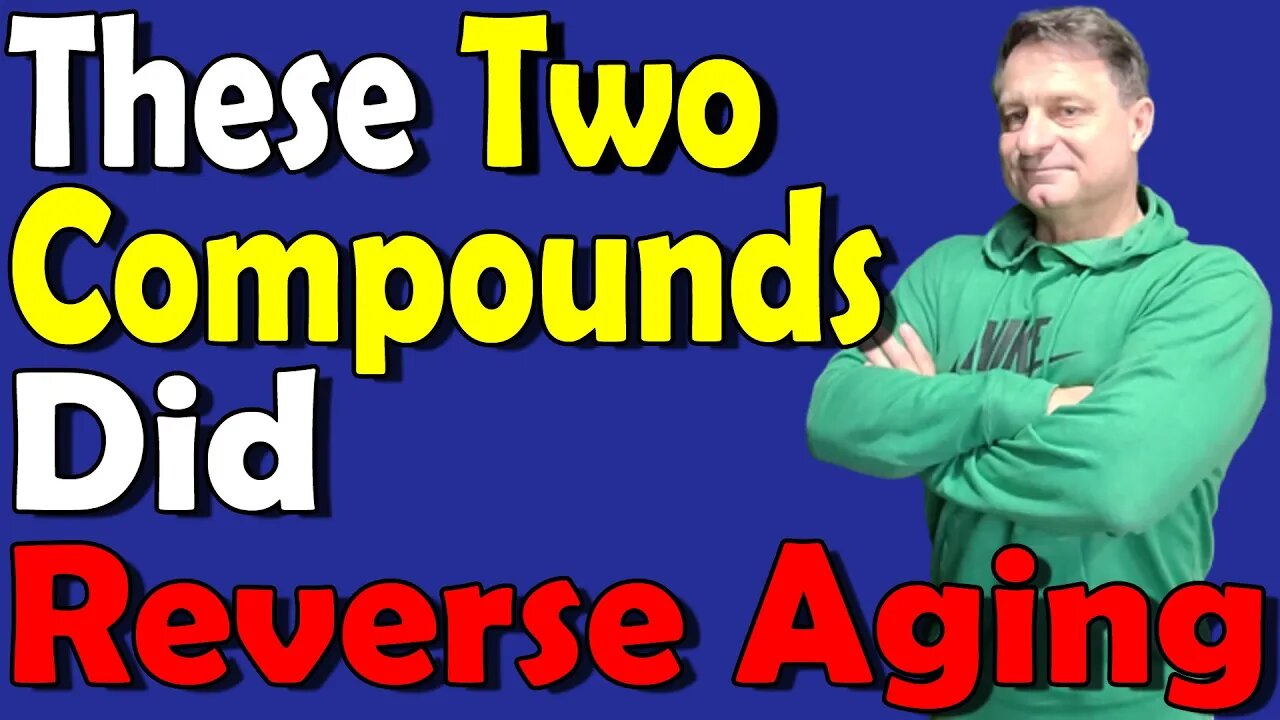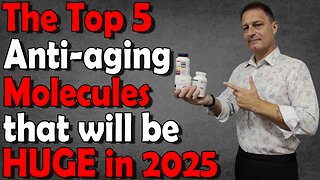Premium Only Content

Latest Research: 2 Compounds that DO REVERSE AGING
A new study out of China has tested 5 different compounds and found that 2 of them did actually, as they say in the paper “significantly diminished the predicted age.”
Renue by Science 10% Discount Code: MYNMN (https://renuebyscience.com/?rfsn=5692699.331801&coupon-code=MYNMN)
Renue by Science 15% Subscription Service Discount Code: MYNMNSUB
DoNotAge.org 10% Discount Code: MYNMN (https://bit.ly/2VBDgNt)
I hope you enjoy my content and find it interesting or informative, if so, please consider supporting the channel by using one of the links below:
*Buy me a Kofi: https://ko-fi.com/mynmnexperiment
*Patreon: https://bit.ly/3hhfjl5
*SubscribeStar: https://bit.ly/3psYo23
My Current Anti-Aging Protocol:
• 1.5 grams of NMN (https://bit.ly/3c2Fxt8)
• 1.5 grams of Trans-resveratrol (Tue, Thu & Sat) (https://bit.ly/3yxeqy2)
• 500mg Metformin
• 1.5 grams of TMG (https://bit.ly/3oe1Ted)
• 5,000 IU (International Units) of vitamin D3 (https://bit.ly/3P32hYH)
• 120 mcg (micrograms) of vitamin K2 (Mk 7) (https://bit.ly/3PhkBgn)
• 250mg Magnesium (L-Threonate) (https://bit.ly/3O4pZ5o)
• 200mg high molecular weight hyaluronic acid (https://bit.ly/3P0Z4c2)
• 2,400mg of Fisetin, on the 1st, 2nd & 3rd of each month (https://bit.ly/3P2rSB0)
• 2,400mg of Quercetin, on the 1st, 2nd & 3rd of each month (https://bit.ly/3IzulAy)
• 81mg of aspirin (https://bit.ly/3uFjtem)
• 800mg SIRT6 Activator
• 600mg DIM
Links:
https://pubmed.ncbi.nlm.nih.gov/36382193/
https://www.ncbi.nlm.nih.gov/pmc/articles/PMC9619353/
https://www.biorxiv.org/content/10.1101/2022.01.17.476558v1
https://www.sciencedirect.com/science/article/pii/S2001037022004688
United Nations, Department of Economic and Social Affairs, Population Division (2019). World Population Prospects 2019: Highlights. ST/ESA/SER.A/423.
The world has a rapidly expanding population of people over age 65, this has, of late, been dubbed the “silver tsunami.” Life expectancy has increased dramatically in the past 150 years. It is expected that worldwide 1.5 billion people aged 65 years or over will outnumber adolescents and the youth aged 15 to 24 years (1.3 billion) in 2050. People aged 65 years and older are experiencing the aging process, characterized by progressive impairment and loss of physiological integrity and function, leading to an increased vulnerability to death. It is without question that the world is facing an aging challenge. Currently, scientists in the aging research field continue to gauge and compare how fast people age with newly devised aging clocks to enable research on the most effective means to combat the ravages of aging. This will require a standardized measurement of aging, many in the aging research field are now turning toward transcript-mics – measuring RNA sequences as an indicator of gene activity. By using transcriptomics to assess people’s pace of aging, we can now compare compounds that have previously been shown to counter aging in animal studies.
Published in the journal Computational and Structural Biotechnology, HongWei Ouyang PhD and his colleagues from Zhejiang University School of Medicine in China have generated a transcriptomics-based aging clock.
Using their clock, they demonstrated that applying NMN or metformin to blood samples reduces predicted age.
The team identified that slow-aging individual’s exhibit blood immune cell levels indicative of less inflammation than fast-aging individuals.
The development of this new aging clock may contribute to anti-aging scientists’ quest for a standardized means to measure biological aging, which can then be used for comparing compounds that can potentially increase the years that we live in good health – known as healthspan.
The genes coded in our DNA are transcribed to mRNA before being translated into a protein, so by measuring mRNA levels gene activity can be assessed. The “transcriptome” encompasses the most active genes at a given time. The researchers analyzed the blood cell transcriptomes of 505 individuals aged between 18 and 68 and found that 1,138 mRNA transcripts had significantly changed with age. Using statistical analyses, the team used the mRNA transcript levels to determine gene activity and predict biological age, this being a person’s physiological age in relation to their age-matched counterparts. In doing so, Dr. Ouyang and his colleagues found that people could be divided into three populations.
DISCLAIMER: This video and description contain discount codes, which means that if you use the code, I will receive a small commission.
FAIR-USE COPYRIGHT DISCLAIMER
Copyright Disclaimer Under Section 107 of the Copyright Act 1976, allowance is made for "fair use" for purposes such as criticism, commenting, news reporting, teaching, scholarship, and research. Fair use is a use permitted by copyright statute that might otherwise be infringing. Non-profit, educational, or personal use tips the balance in favor of fair use. #Glucophage #Metformin #NicotinamideMononucleotide
-
 6:07
6:07
My Longevity Experiment
7 months ago $0.05 earnedTop 5 Longevity Supplements for 2025 | A Data Driven List
1563 -
 14:09
14:09
Zoufry
3 days agoThe Cartel's Genius Border Smuggling Tricks
16.9K7 -
 2:00:26
2:00:26
MG Show
19 hours agoPresident Trump Making BIG Deals in UK & EU; Structure Change
48.2K21 -
 23:09
23:09
GritsGG
16 hours agoQuad Domination w/ Bobby Poff!
47.9K2 -
 2:03:21
2:03:21
Side Scrollers Podcast
20 hours agoTea App Doxxing DISASTER, “PROBLAMATIC” Sydney Sweeny, INSANE Online “Safety” Act | Side Scrollers
17.8K10 -
 LIVE
LIVE
Lofi Girl
2 years agoSynthwave Radio 🌌 - beats to chill/game to
334 watching -
 1:32:48
1:32:48
Omar Elattar
8 months agoAndy Elliott: "Quit Your Excuses Now!" How to 10x Your Income In 12 Months!
14.9K5 -
 2:02:10
2:02:10
Inverted World Live
11 hours agoGhislaine Maxwell Gives 100 Names to DOJ | Ep. 81
290K35 -
 2:51:11
2:51:11
TimcastIRL
11 hours agoBREAKING: MASS SHOOTING ERUPTS In NYC, Police Officer SHOT, FBI On Scene | Timcast IRL
289K148 -
 14:43:03
14:43:03
ZWOGs
18 hours ago🔴LIVE IN 1440p! - EFT w/ crgoodw1n, Kingdom Come Deliverance, Splitgate 2, & More! - Come Hang Out!
69.2K4